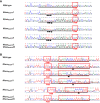Generation of transgene-free canker-resistant Citrus sinensis cv. Hamlin in the T0 generation through Cas12a/CBE co-editing
- PMID: 38595767
- PMCID: PMC11002166
- DOI: 10.3389/fpls.2024.1385768
Generation of transgene-free canker-resistant Citrus sinensis cv. Hamlin in the T0 generation through Cas12a/CBE co-editing
Abstract
Citrus canker disease affects citrus production. This disease is caused by Xanthomonas citri subsp. citri (Xcc). Previous studies confirmed that during Xcc infection, PthA4, a transcriptional activator like effector (TALE), is translocated from the pathogen to host plant cells. PthA4 binds to the effector binding elements (EBEs) in the promoter region of canker susceptibility gene LOB1 (EBEPthA4-LOBP) to activate its expression and subsequently cause canker symptoms. Previously, the Cas12a/CBE co-editing method was employed to disrupt EBEPthA4-LOBP of pummelo, which is highly homozygous. However, most commercial citrus cultivars are heterozygous hybrids and more difficult to generate homozygous/biallelic mutants. Here, we employed Cas12a/CBE co-editing method to edit EBEPthA4-LOBP of Hamlin (Citrus sinensis), a commercial heterozygous hybrid citrus cultivar grown worldwide. Binary vector GFP-p1380N-ttLbCas12a:LOBP1-mPBE:ALS2:ALS1 was constructed and shown to be functional via Xcc-facilitated agroinfiltration in Hamlin leaves. This construct allows the selection of transgene-free regenerants via GFP, edits ALS to generate chlorsulfuron-resistant regenerants as a selection marker for genome editing resulting from transient expression of the T-DNA via nCas9-mPBE:ALS2:ALS1, and edits gene(s) of interest (i.e., EBEPthA4-LOBP in this study) through ttLbCas12a, thus creating transgene-free citrus. Totally, 77 plantlets were produced. Among them, 8 plantlets were transgenic plants (#HamGFP1 - #HamGFP8), 4 plantlets were transgene-free (#HamNoGFP1 - #HamNoGFP4), and the rest were wild type. Among 4 transgene-free plantlets, three lines (#HamNoGFP1, #HamNoGFP2 and #HamNoGFP3) contained biallelic mutations in EBEpthA4, and one line (#HamNoGFP4) had homozygous mutations in EBEpthA4. We achieved 5.2% transgene-free homozygous/biallelic mutation efficiency for EBEPthA4-LOBP in C. sinensis cv. Hamlin, compared to 1.9% mutation efficiency for pummelo in a previous study. Importantly, the four transgene-free plantlets and 3 transgenic plantlets that survived were resistant against citrus canker. Taken together, Cas12a/CBE co-editing method has been successfully used to generate transgene-free canker-resistant C. sinensis cv. Hamlin in the T0 generation via biallelic/homozygous editing of EBEpthA4 of the canker susceptibility gene LOB1.
Keywords: CRISPR; Cas12a; Citrus; Xanthomonas; citrus canker; transgene-free genome editing.
Copyright © 2024 Jia, Omar, Xu, Dalmendray, Wang, Feng, Wang, Hu, Grosser and Wang.
Conflict of interest statement
The authors declare that the research was conducted in the absence of any commercial or financial relationships that could be construed as a potential conflict of interest. The author(s) declared that they were an editorial board member of Frontiers, at the time of submission. This had no impact on the peer review process and the final decision.
Figures







Similar articles
-
LbCas12a-D156R Efficiently Edits LOB1 Effector Binding Elements to Generate Canker-Resistant Citrus Plants.Cells. 2022 Jan 18;11(3):315. doi: 10.3390/cells11030315. Cells. 2022. PMID: 35159125 Free PMC article.
-
Biallelic Editing of the LOB1 Promoter via CRISPR/Cas9 Creates Canker-Resistant 'Duncan' Grapefruit.Phytopathology. 2022 Feb;112(2):308-314. doi: 10.1094/PHYTO-04-21-0144-R. Epub 2022 Feb 3. Phytopathology. 2022. PMID: 34213958
-
Modification of the PthA4 effector binding elements in Type I CsLOB1 promoter using Cas9/sgRNA to produce transgenic Duncan grapefruit alleviating XccΔpthA4:dCsLOB1.3 infection.Plant Biotechnol J. 2016 May;14(5):1291-301. doi: 10.1111/pbi.12495. Epub 2015 Nov 2. Plant Biotechnol J. 2016. PMID: 27071672 Free PMC article.
-
Generation of the transgene-free canker-resistant Citrus sinensis using Cas12a/crRNA ribonucleoprotein in the T0 generation.Nat Commun. 2023 Jul 5;14(1):3957. doi: 10.1038/s41467-023-39714-9. Nat Commun. 2023. PMID: 37402755 Free PMC article.
-
Citrus Canker Pathogen, Its Mechanism of Infection, Eradication, and Impacts.Plants (Basel). 2022 Dec 26;12(1):123. doi: 10.3390/plants12010123. Plants (Basel). 2022. PMID: 36616252 Free PMC article. Review.
Cited by
-
Cas12a RNP-mediated co-transformation enables transgene-free multiplex genome editing, long deletions, and inversions in citrus chromosome.Front Plant Sci. 2024 Aug 1;15:1448807. doi: 10.3389/fpls.2024.1448807. eCollection 2024. Front Plant Sci. 2024. PMID: 39148610 Free PMC article.
-
Genome editing for sustainable agriculture in Peru: advances, potential applications and regulation.Front Genome Ed. 2025 Jun 30;7:1611040. doi: 10.3389/fgeed.2025.1611040. eCollection 2025. Front Genome Ed. 2025. PMID: 40661867 Free PMC article. Review.
-
Genetic engineering, including genome editing, for enhancing broad-spectrum disease resistance in crops.Plant Commun. 2025 Feb 10;6(2):101195. doi: 10.1016/j.xplc.2024.101195. Epub 2024 Nov 20. Plant Commun. 2025. PMID: 39568207 Free PMC article. Review.
-
Recent advances in innovative strategies for plant disease resistance breeding.Front Plant Sci. 2025 May 21;16:1586375. doi: 10.3389/fpls.2025.1586375. eCollection 2025. Front Plant Sci. 2025. PMID: 40470369 Free PMC article. Review.
-
In planta genome editing in citrus facilitated by co-expression of CRISPR/Cas and developmental regulators.Plant J. 2025 Apr;122(2):e70155. doi: 10.1111/tpj.70155. Plant J. 2025. PMID: 40275470 Free PMC article.
References
LinkOut - more resources
Full Text Sources
Research Materials
Miscellaneous

